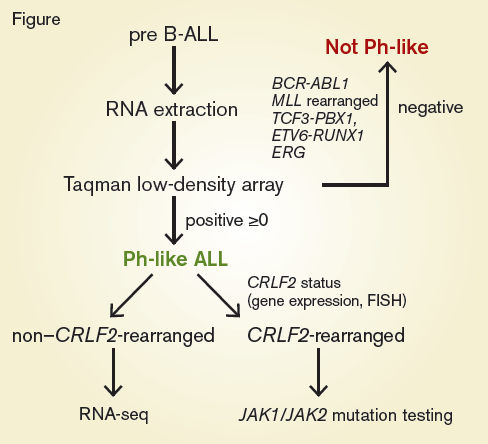Philadelphia chromosome–like (Ph-like) acute lymphocytic leukemia (ALL), first described in 2009, has a gene expression profile similar to Ph-positive ALL but lacks BCR-ABL1 and has been independently associated with a poor prognosis.1,2 Notably, the majority of patients with Ph-like ALL have underlying genetic alterations in kinase or cytokine receptor signaling pathways that can be targeted with available tyrosine kinase inhibitors (TKIs) — an approach supported by preclinical studies and individual case reports. While the prevalence of Ph-like ALL has been shown to increase with age ranging from 10 to 15 percent in children up to 27 percent in young adults,3 the prevalence of this high-risk subtype in older adults was not previously established.
To address this question, Dr. Kathryn G. Roberts and colleagues completed an international study analyzing 798 patients with B-cell ALL (B-ALL), aged 21 to 86 years. Comprehensive genomic analyses were completed using banked leukemia samples to determine the frequency of Ph-like ALL in adults. Another aim of this study was to identify the underlying kinase-activating alterations and to compare the findings to those observed in children and adolescents.
Flow Chart for the Identification of Kinase Alterations in Philadelphia Chromosome-like (Ph-like) Acute Lymphocytic Leukemia (ALL). Abbreviations: B-ALL, B-cell ALL; FISH, fluorescence in situ hybridization.
Flow Chart for the Identification of Kinase Alterations in Philadelphia Chromosome-like (Ph-like) Acute Lymphocytic Leukemia (ALL). Abbreviations: B-ALL, B-cell ALL; FISH, fluorescence in situ hybridization.
For the analyses, the patient population was subdivided into three age groups: young adults (21-39 years of age), adults (40-59 years of age), and older adults (60-86 years of age). The expression of 15 genes by either microarray or a quantitative reverse-transcriptase polymerase chain reaction low density array (LDA) screening card was assessed and patients with an LDA coefficient of 0.5 to 1 were designated positive for Ph-like ALL. Additional confirmatory testing, including fluorescence in situ hybridization (FISH) and transcriptome sequencing, was completed in LDA screen positive patients to identify specific underlying genetic alterations (Figure).
The authors found a high frequency of Ph-like ALL across the adult age spectrum, occurring in 194 patients (24.3%) overall. When examining adult age subsets, Ph-like ALL was identified in 27.9 percent, 20.4 percent and 24 percent of the young adults, adults and older adults, respectively. As demonstrated in previous studies, the Ph-like subtype conferred a poor prognosis. Five-year survival for adults with Ph-like ALL was 23.8 percent compared with 52.4 percent for adults with non–Ph-like ALL, excluding BCR-ABL1 and KMT2A-rearranged ALL. The outcome differences were most significant in young adults where five-year survival for Ph-like ALL was 25.4 percent compared to 64.2 percent for non–Ph-like ALL. Eighty-eight percent of the Ph-like patient population was confirmed to have an underlying alteration activating kinase signaling. The most common alterations were cytokine receptor-like factor 2 (CRLF2) rearrangements, which occurred at the highest frequency in older adults (58.4%). Additional findings included ABL1 class fusions (9.8%) along with mutations and rearrangements in the JAK-STAT and Ras pathways. Overall, approximately 70 percent of the patient population had an underlying genetic lesion targetable with a JAK inhibitor. Notably, the investigators identified several fusions that were previously unreported in Ph-like ALL. Aside from EPOR rearrangements, which were more common in younger adults, the frequency of specific underlying alterations did not differ across age groups and kinase-activing alteration profiles identified in adults with Ph-like ALL were similar to those previously reported in children. Another recent study by Dr. Nitin Jain and colleagues also confirmed a high prevalence and poor prognosis of Ph-like ALL in adults.4
In Brief
This report demonstrates that Ph-like ALL is common across the age spectrum. The translational implications are significant because the vast majority of patients with Ph-like ALL have alterations that are targetable with existing therapies. Trials evaluating TKI therapy with either dasatinib for ABL1 class fusions or ruxolitinib for CRLF2 rearrangements or JAK-STAT pathway alterations, in combination with chemotherapy, are presently underway in both children (NCT02883049, NCT02723994) and adults (NCT02420717) with Ph-like ALL. These studies will provide essential information about the optimal treatment approach for this high-risk disease subtype.
In addition to defining the optimal treatment strategies for Ph-like ALL, there are additional challenges for the future surrounding the efficiency and accessibility of testing. Eleven new targetable fusions were identified in this study suggesting that more comprehensive sequencing approaches may be needed in the future to precisely identify all Ph-like patients. Given the prevalence, prognostic significance, and potential treatment implications, future efforts are needed to ensure that testing is broadly available.
References
Competing Interests
Dr. Raetz indicated no relevant conflicts of interest.

